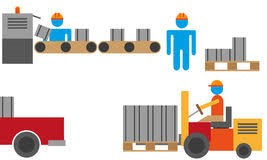 In our previous article, we introduced you all to our rising star “RAGHAV”. We saw all its magnificent features and functionalities. What we deliberately left out was the wide range of applications RAGHAV has in all the manufacturing industries. Each industry differs when it comes to material handling needs and so do their issues. You must be wondering how does RAGHAV solve all these issues efficiently? This is exactly what we are going to see in our articles hence forward.
In our previous article, we introduced you all to our rising star “RAGHAV”. We saw all its magnificent features and functionalities. What we deliberately left out was the wide range of applications RAGHAV has in all the manufacturing industries. Each industry differs when it comes to material handling needs and so do their issues. You must be wondering how does RAGHAV solve all these issues efficiently? This is exactly what we are going to see in our articles hence forward.
Let us start with automobile industry, which we are all quite familiar with. Productivity is by far the most important factor for automobile industry as it directly affects the profit margins. Productivity is the measure of efficiency of production. Given that, it is obvious to infer that any businessman would definitely want to have the productivity to be on the higher side, to reap the maximum benefits of his business by making more and more profits. But what are the factors affecting productivity? What are the main causes for loss in productivity? You will get your answers in our today’s discussion, Productivity in Automobile.
In a simple term, productivity can be defined as the ratio of actual output to the inputs required to produce that output. This means that the various input processes like manufacturing, assembly, material handling are primarily responsible for the actual productivity and profits of a company. Over the years, studies have suggested that material handling is one such process, which adds very less value to the finished product, and hence has a big negative impact on productivity. Now let us try to analyze how material handling, if not done properly, can tamper with all possible inputs and single handedly bring down the productivity.
- Raw Material: It is an input, which is required in the first stage of manufacturing. Transporting this raw material from the warehouse region to the manufacturing region of the plant requires material handling. If this is done manually, the probable losses in the raw material are more because of unavoidable human errors.
- Labor: Labor costs are the highest in any industry and
 companies have been striving hard to reduce thosesince ages. Introduction of automation in manufacturing and assembly lines, has made that possible to a certain extent. But as seen above, if the handling of raw material or finished parts from one section to the other on the shop floor is done manually, the labor costs increase unnecessarily by manifold. Even though the company has options like conveyors or forklifts, they are still to be operated manually, thus increasing the risk of damage to products. Also when done manually, the time taken for transportation is much more, which adds up as an overhead and increases the production cost. All these factors contribute to lowering the overall productivity.
companies have been striving hard to reduce thosesince ages. Introduction of automation in manufacturing and assembly lines, has made that possible to a certain extent. But as seen above, if the handling of raw material or finished parts from one section to the other on the shop floor is done manually, the labor costs increase unnecessarily by manifold. Even though the company has options like conveyors or forklifts, they are still to be operated manually, thus increasing the risk of damage to products. Also when done manually, the time taken for transportation is much more, which adds up as an overhead and increases the production cost. All these factors contribute to lowering the overall productivity.
- Capital: In case of manual labor, they have to be provided with training at regular intervals and safety equipment, which adds to the cost. The regular maintenance of conveyors, forklifts and other machinery also increases the input cost. Material handling costs are always considered as overheads since they do a little value addition to the actual product. While calculating productivity, these added costs contribute to the total capital input and consequently reduce the productivity.
- Time: Time is one of the most significant inputs, which contributes to the production. As seen above, if material handling is done manually, the time taken to transport loads, which are usually heavy in any automobile industry, is considerably far more than when done autonomously. Similarly, although conveyors or forklifts are used, their downtime needs to be considered as they cannot be operated 24×7. This loss of time reduces the actual production and thus hampers productivity.
We can conclude from the above facts that, material handling when not done appropriately, affects so many other factors, which are inputs to the production. In turn, these increased inputs reduce the overall productivity. According to statistics, material handling in Indian industries accounts to 40% of the cost of production. When such high numbers are at stake, imagine the gain in productivity even if we are able to reduce the material handling costs by little margin. Industries will be happy because of their increased profits. Increased production means increase in the availability, which indirectly reduces the cost of the products for customers, making them happy. This not only helps in the industrial growth, but also for the economic growth of a nation.
We have seen what factors affect the productivity in an automobile industry. How can RAGHAV help solve this issue of non productivity? Stay tuned to find out in our next article.


